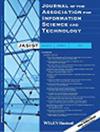Two Models for Predicting Subject Circulation: A Contribution to the Allocation Problem
Journal of the American Society for Information Science and Technology
Pub Date : 2007-09-06
DOI:10.1002/asi.4630300504
引用次数: 1
Abstract
It is shown that different sets of variables can account for nearly equal amounts of variance when predicting book circulation by subject. Proportion of variance (R2) for two basic models containing various combinations of 21 variables were tested. The first, called the shelf list model, treated the number of library books, whose subjects match those of academic departments, as a control variable. As such, it accounted for 6Wo of the variance, thus entering the equation first. With this model, four separate significant sets emerged, each accounting for approximately thb same amount of variance (10%). They were (1) number of faculty, hardhoft, masters enrollments; (2) masters enrollments, upper-level majors, hardhoft; (3) credit hours X total enrollments, hardhoft; (41 tipper-level majors, total majors, enrollments lower. In the second, shelf list was constrained by defining the dependent variable as the proportion of shelf list circulated. With this model, three separate significant sets emerged. These were (5) masters enrollments and hardhoft (20% variance); (6) hard-soft and Ph.D. program (16%); (7) upper-level majors, and credit hours × total majors (15%). In each of the tests, no other variables were significant. Of the 21 variables, 10 did not appear in any of the 7 sets. Any of the seven sets could be used in an allocation formula. The deciding criterion for choosing a set may depend on the convenience of collecting data for each of the variables in the set.预测学科流通的两种模型:对分配问题的贡献
研究表明,在按主题预测图书流通时,不同的变量集可以解释几乎相等的方差。对包含21个变量的不同组合的两个基本模型进行方差比(R2)检验。第一个模型称为书架列表模型,它将图书馆图书的数量作为控制变量,这些图书的主题与学术部门的图书相匹配。因此,它占方差的6Wo,因此首先进入方程。在这个模型中,出现了四个独立的显著集,每个显著集占大约相同的方差量(10%)。它们是:(1)教师人数,教师人数,硕士人数;(2)硕士生招生情况,高级专业招生情况;(3)学时X总学时,hardhoft;(41)一级专业,总专业,招生人数较低。第二步,将因变量定义为货架清单流通比例,对货架清单进行约束。根据这个模型,出现了三个独立的显著集合。这些是(5)硕士入学人数和硬汉(20%方差);(6)软硬及博士研究生(16%);(7)上层专业,学时×总专业(15%)。在每个测试中,没有其他变量是显著的。在21个变量中,有10个变量没有出现在7个集合中的任何一个集合中。这七组中的任何一组都可以用于分配公式。选择集合的决定标准可能取决于集合中每个变量收集数据的便利性。
本文章由计算机程序翻译,如有差异,请以英文原文为准。
求助全文
约1分钟内获得全文
求助全文
来源期刊
自引率
0.00%
发文量
0
审稿时长
3.5 months

 求助内容:
求助内容: 应助结果提醒方式:
应助结果提醒方式:


